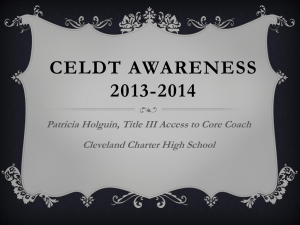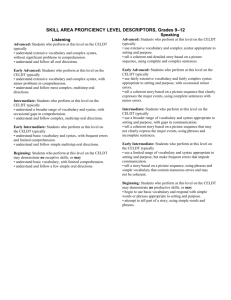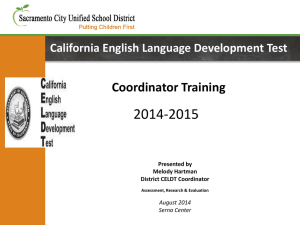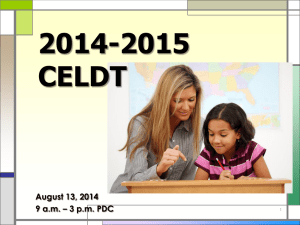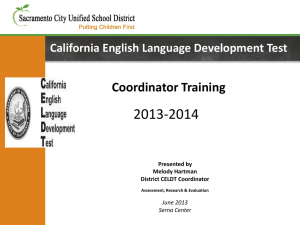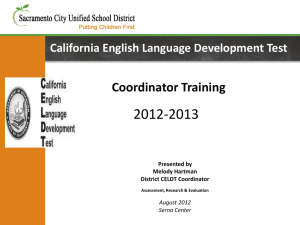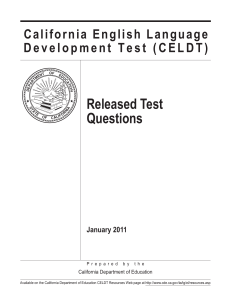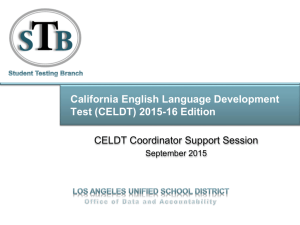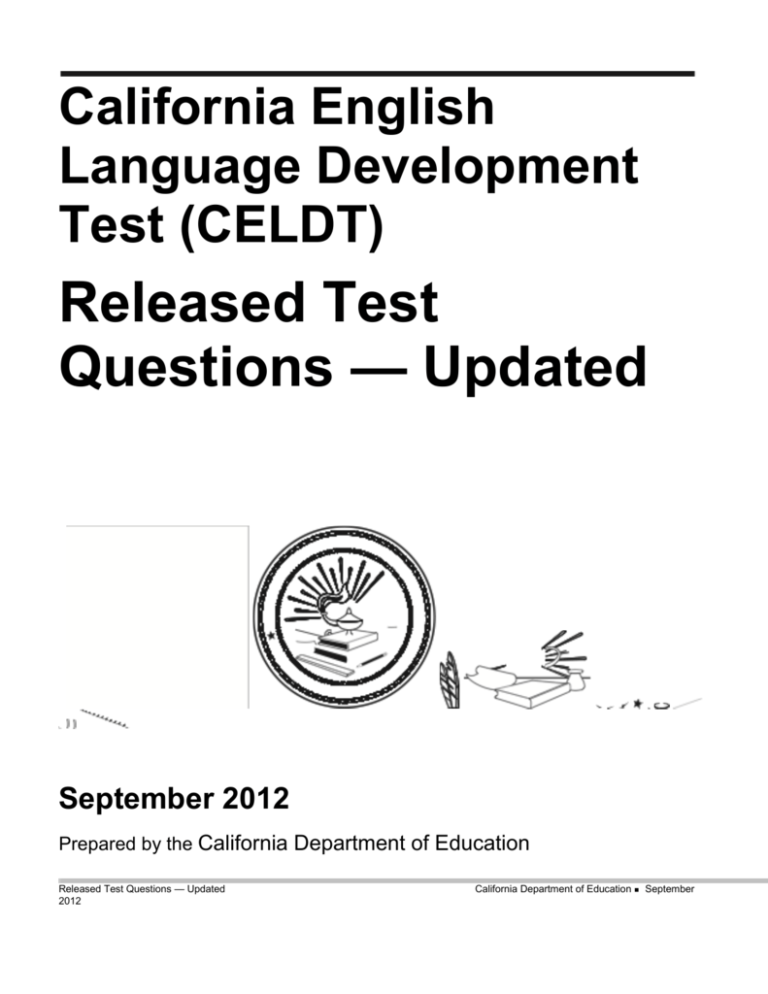
California English
Language Development
Test (CELDT)
Released Test
Questions — Updated
September 2012
Prepared by the California Department of Education
Released Test Questions — Updated
2012
California Department of Education September
Available on the California Department of Education CELDT Resources Web page at
http://www.cde.ca.gov/ta/tg/el/resources.asp
Copyright © 2012 by the California Department of Education (CDE). All rights
reserved. This document may be copied and distributed by individuals and by
California local educational agencies. This document and its contents may not
be edited or altered, and must remain unchanged as published by the CDE.
Any other use or reproduction of this document, in whole or in part, requires
written permission from the CDE.
Released Test Questions — Updated
2012
California Department of Education September
California English languagE DEvElopmEnt tEst
CELDT Released Test Questions — Updated
Table of Contents
Introduction
..........................................................................................................................1
Released Test Questions
Overview ..........................................................................................................................3 Test
Components by Domain ............................................................................................... 6 Released
Test Questions by Grade and Domain
Grades Six Through Eight (Listening, Speaking, Reading, and
Writing).......................................................................................................... 50
Appendixes
Copying Letters ............................................................................................. 88 Copying
Words.............................................................................................. 88 Write the Word (Picture
Prompt) ................................................................... 88 Write a Word (Story Prompt)
........................................................................ 89
Kindergarten Through Grade Twelve — Speaking
Choose and Give
Reasons......................................................................................... 90 4-Picture
Narrative........................................................................................................ 91 Speech
Functions.......................................................................................... 93
Grades Two Through Twelve — Writing
Released Test Questions — Updated
2012
California Department of Education September
Sentences......................................................................................................
94
Short Compositions ...................................................................................... 96 Appendix B:
Overall Test Performance Descriptors ................................ 99
Released Test Questions — Updated
California English languagE DEvElopmEnt tEst
Introduction
State law (California Education Code sections 313 and 60810) and federal law (Title III of the
Elementary and Secondary Education Act [ESEA]) require that local educational agencies (LEAs)
administer an initial assessment (IA) of English language proficiency to newly enrolled students
whose primary language is not English and an annual assessment (AA) to students who have
been previously identified as English learners (ELs). For California’s public school students, this
test is the California English Language Development Test (CELDT).
The CELDT has three purposes:
n To identify students who are limited English proficient (LEP)
n To determine the level of English language proficiency of LEP students
n To assess the progress of LEP students in acquiring the skills of Listening, Speaking, Reading,
and Writing in English
The purpose of this document is to provide CELDT question samples (i.e., released test
questions or RTQs) for site and LEA administrators, teachers, and parents
or guardians. These
questions cover the four domains assessed by the CELDT: Listening, Speaking, Reading, and
Writing. This updated document, which reflects minor revisions in the scoring rubrics for writing,
and a glossary are available on the California Department of Education (CDE) CELDT Resources
Web page at http://www.cde.ca.gov/ta/tg/el/resources.asp.
Released Test Questions — Updated
2012
California Department of Education September
California English languagE DEvElopmEnt tEst
Released Test Questions
Overview
Test Components by Domain
Released Test Questions by Grade and Domain
Grades Six Through Eight (Listening, Speaking, Reading, and Writing)
2
Released Test Questions — Updated
2012
California Department of Education September
California English languagE DEvElopmEnt tEst
Overview
This document contains 80 test questions from CELDT administrations, ranging from 2003–04
through 2009–10. The questions are organized by grade and cover the four domains assessed by
the CELDT: Listening, Speaking, Reading, and Writing. Each question includes the English
Language Development (ELD) standard addressed, the test component, the scoring method
used, and information on student performance. Graphics for the questions have been reduced to
fit onto the pages.
Question Development
All questions on the CELDT address the ELD standards approved by the State Board of
Education (SBE) in 1999. These standards define what ELs in California’s public schools are
expected to know and be able to do as they progress toward English language proficiency.
Written by trained educators, CELDT questions go through a quality review process to ensure
alignment to the ELD standards and content appropriateness. After field testing, questions that
meet a rigorous set of statistical criteria may be selected for a future operational test form. The
complete English-Language Development Standards for California Public Schools document is
available on the CDE Administrative Forms and Documents Web page at
http://www.cde.ca.gov/ta/tg/el/admin.asp.
Test Components by Domain
Within each domain, there are several test components. The way each question
is administered
varies depending on the test component addressed. For example, questions could be presented
orally or in writing, and responses by the student could be presented orally or in writing as well.
The “Test Components by Domain” chart on pages 6 and 7 describes the types of questions
asked and how students are expected to respond.
California English languagE DEvElopmEnt tEst
Released Test Questions — Updated
2012
California Department of Education September
Student Performance
Statistics provided with each question show how students scored at each performance level on a
specific CELDT administration. Multiple-choice questions are scored as “0” for Incorrect or “1” for
Correct. Short-response questions also are scored as “0” for No Response or Incorrect, or “1” for
Correct. Both No Response and Incorrect are scored as “0.”
Other types of questions in the CELDT are scored based on a rubric. Scoring rubrics are used to
assign a score to a student’s oral or written responses, using a range of score points. Sample
student responses are provided for questions requiring longer oral responses and written
sentences or paragraphs. Table 1 provides an example
of students’ overall performance at the
statewide level on a multiple-choice question. Table 2 provides an example of students’ overall
performance at the statewide level on a 4-Picture Narrative question that was evaluated with a
scoring rubric.
Student Performance: Table 1
(Multiple-choice questions)
Overall Performance Level on the CELDT
% Scored Correctly
Beginning
65
Early Intermediate
84
Intermediate
91
Early Advanced
95
Advanced
96
The column on the left refers to the students’ overall performance levels on the CELDT. The
CELDT results are reported according to five levels: Beginning, Early Intermediate, Intermediate,
Early Advanced, and Advanced. The column on the right refers to the percentage of students who
answered the question correctly at each overall performance level. In this example, 65 percent of
the students scoring at the Beginning level answered the question correctly, suggesting that the
test question was somewhat challenging for that group. In contrast, 96 percent of the students
who performed at the Advanced level answered the question correctly.
During the development of the 2012–13 Edition, the rubrics underwent minor revisions aimed at
refining the scoring process and providing more distinction between score points. The revisions
should not significantly change students’ scores; therefore, the overall student performance
provided for earlier CELDT editions is still accurate.
California English languagE DEvElopmEnt tEst
Released Test Questions — Updated
2012
California Department of Education September
Student Performance: Table 2 (4-Picture Narrative question)
Overall Performance Level on the CELDT
Average Score Based on Rubric
Beginning
0.2
Early Intermediate
1.2
Intermediate
2.1
Early Advanced
2.9
Advanced
3.5
Table 2 shows the average score for a 4-Picture Narrative question that was scored with a
scoring rubric ranging from 0–4 score points. For this question, students scoring at the Beginning
level had an average score very close to zero (no response or not intelligible). Advanced students
scored between 3 and 4 on the scoring rubric, responding with a developed vocabulary and very
minor errors that did not affect the meaning.
Scoring Rubrics
Constructed-response questions for the CELDT are scored using a scoring rubric. Scores on
those questions could vary as follows:
0–1 Points: Copying Letters (K–1)
0–2 Points: Copying Words, Write the Word, and Write a Word (K–1), Choose and Give Reasons
(K–12), and Speech Functions (K–12)
0–3 Points: Word Analysis (K–1) and Sentences (2–12)
0–4 Points: 4-Picture Narrative (K–12)
and Short Compositions (2–12)
All the CELDT scoring rubrics are available in Appendix A.
Multiple-choice questions (scored as Incorrect or Correct) and short-response questions (scored
as No Response, Incorrect, or Correct) do not have scoring rubrics.
Overall Test Performance Descriptors
Overall test performance descriptors, which are available in Appendix B, describe the
competencies associated with each performance level. There are two charts that describe each
performance level: one for K–1 and one for 2–12. These descriptors characterize what students
at each performance level are expected to know and be able to do as they progress toward
English language proficiency.
Released Test Questions — Updated
2012
California Department of Education September
Test Components by Domain
Write the Word (picture prompt) Write a Word (story prompt)
Administered orally and individually. Students are asked to copy letters and words.
CELDT Questions
K–12 Listening
California English languagE DEvElopmEnt tEst
Released Test Questions — Updated
2012
California Department of Education September
Grades Six Through Eight — Listening
Following Oral Directions
ELD Standard:
Restate and execute multiple-step oral directions.
Scoring:
This question was scored as Incorrect or Correct.
Student Performance:
The table below shows how students performed in the 2003–04
administration.
say Choose
the picture that shows a line connecting the bus to the truck. Mark your
answer.
00382942
BCD
Overall Performance Level on the CELDT
Beginning Early Intermediate Intermediate Early Advanced Advanced
ELD Standard:
% Scored Correctly
78 96 98 99 100
Released Test Questions — Updated
2012
California Department of Education September
Overall Performance Level on the CELDT
Beginning Early Intermediate Intermediate Early Advanced Advanced
% Scored Correctly
60 85 96 99
100
teacher talk
say A
teacher tells the class: Let’s take a minute to talk about how we will turn in
homework. Starting on Monday, I am not going to walk around each morning to
collect your homework. Instead, you will drop your homework in the basket on my
desk.
What is the teacher talking about?
the answers to a homework assignment
a new way of turning in homework when a book report is due
00383010
Listen attentively to stories and information and identify important details and
concepts by using both verbal and nonverbal responses.
Scoring:
This question was scored as Incorrect or Correct.
Student Performance:
The table below shows how students performed in the 2004–05
administration.
Released Test Questions — Updated
2012
California Department of Education September
Released Test Questions — Updated
2012
California Department of Education September

